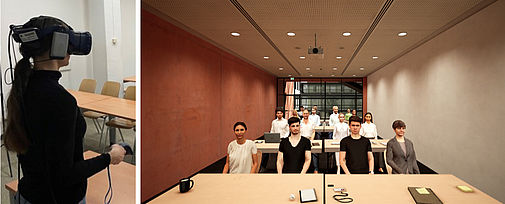How Does Virtual Reality Sound?
Psychologists are studying how spatial acoustics change the experience in virtual reality
April 13, 2023
The interdisciplinary priority program (SPP) "Audictive” of the German Research Foundation (DFG) is conducting research on hearing in virtual reality. A cooperation between psychologists from the Department of Clinical Psychology and Psychotherapy and acousticians from the University of Regensburg and the Jade University of Applied Sciences in Oldenburg could also be started at the UR. This project investigates how state-of-the-art spatial acoustics simulation techniques can be used to create highly realistic virtual scenarios (for example, a virtual language course in a seminar room).
The idea is that people in virtual reality should feel as if they were in a real seminar room and surrounded by the attending participants. This requires not only a convincing visual model of the room, but also a realistic-sounding acoustic environment. This is where the methods of acousticians come into play; they use audio rendering to create an auditory impression where it is not possible to distinguish whether the sound source in the room is real or simulated.
In order to create such an auditory impression, individual anatomical differences must be taken into account. For example, the condition of the head, shoulder and especially the auricle influence how sounds are perceived. To characterize this influence, the so-called individual "Head-Related-Transfer-Function" (HRTF) has to be calculated.
 Figure 1: measurement setup for the individual HRTF: subjects take a seat at the center of the arc and are exposed to sound from 24 different loudspeakers in all hearing-relevant frequencies while the arch rotates around the subjects. © Sarah Roßkopf
Figure 1: measurement setup for the individual HRTF: subjects take a seat at the center of the arc and are exposed to sound from 24 different loudspeakers in all hearing-relevant frequencies while the arch rotates around the subjects. © Sarah Roßkopf
Modern game consoles (e.g., Playstation 5) also rely on HRTFs to improve the sound and gaming experience. In the laboratories of the Psychology department in Regensburg, a measuring device has now been put into operation that allows the measurement of individual HRTFs (see Fig. 1). This laid the foundation for excellent simulation of acoustics in virtual environments at the University of Regensburg. The investigations in virtual reality now begin (see Fig. 2).
Figure 2: virtual seminar scenario: spatial hearing and attention processes in virtual reality are studied. © Poto on the left: Sarah Roßkopf / Screenshot on the right: Leon Kroczek
After completion of the currently planned basic studies on the influence of auditory simulation on experience, attention processes and cognitive functions in virtual reality, the findings will be made usable for clinical psychology. Thus, the influence of acoustic processes on the experience of social stress and social anxiety in virtual reality will be studied. The findings can, in turn, be used to optimize therapy for social anxiety disorders, for example. One treatment option is virtual exposure therapy, where patients confront their own fears and give a presentation to virtual agents. The success rates of (virtual) exposure therapies are very high and are the treatment of choice for anxiety disorders.
Information/Contact
Sarah Roßkopf, M.Sc.
Lehrstuhl für Klinische Psychologie und Psychotherapie
Universität Regensburg
Tel.: + 49 (0)941/943-6042
E-Mail: sarah.rosskopf@ur.de





